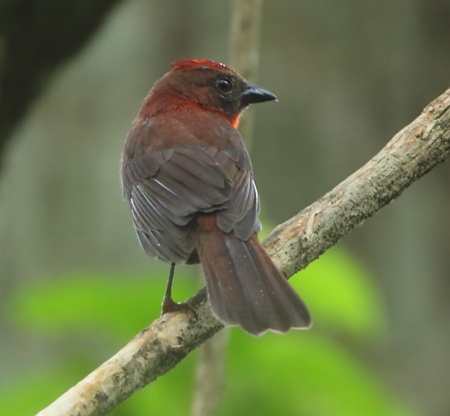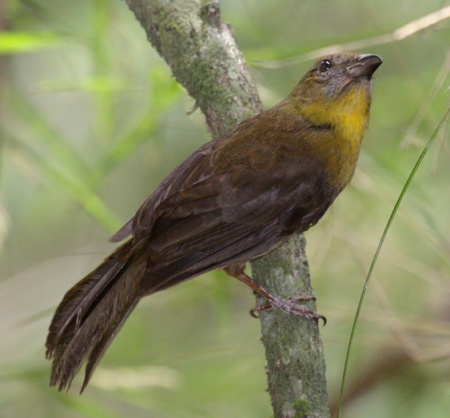m |
m (→Identification) |
||
| Line 5: | Line 5: | ||
===Similar Species=== | ===Similar Species=== | ||
| − | + | Very difficult to distinguish from the [[Red-crowned Ant Tanager]]. However, this species has darker lories, and the red or yellow crown stripe lacks the black edge found on the [[Red-crowned Ant Tanager]]. Both these differences are subtle; best differentiation is voice. | |
==Distribution== | ==Distribution== | ||
Revision as of 18:06, 1 February 2012
- Habia fuscicauda
Identification
19 cm. Dull red, paler below, bright red throat and central crown, dark bill and eyes. The female is brown-olive, paler and greyer below, yellow throat and small dull yellow crown stripe. Young birds are brown and lack the throat and crown patches.
Similar Species
Very difficult to distinguish from the Red-crowned Ant Tanager. However, this species has darker lories, and the red or yellow crown stripe lacks the black edge found on the Red-crowned Ant Tanager. Both these differences are subtle; best differentiation is voice.
Distribution
Taxonomy
Six subspecies are recognized:[1]
- H. f. salvini
- H. f. insularis
- H. f. discolor
- H. f. fuscicauda
- H. f. willisi
- H. f. erythrolaema
Habitat
Thick undergrowth at the edge of forest.
Behaviour
- Breeding: It builds a cup shaped nest in the fork of a shrub or tree and 2-3 white eggs are laid.
- Diet: Includes insects, arthropods and fruit.
References
- Clements, JF. 2008. The Clements Checklist of Birds of the World. 6th ed., with updates to December 2008. Ithaca: Cornell Univ. Press. ISBN 978-0801445019.
Recommended Citation
- BirdForum Opus contributors. (2024) Red-throated Ant Tanager. In: BirdForum, the forum for wild birds and birding. Retrieved 11 May 2024 from https://www.birdforum.net/opus/Red-throated_Ant_Tanager





